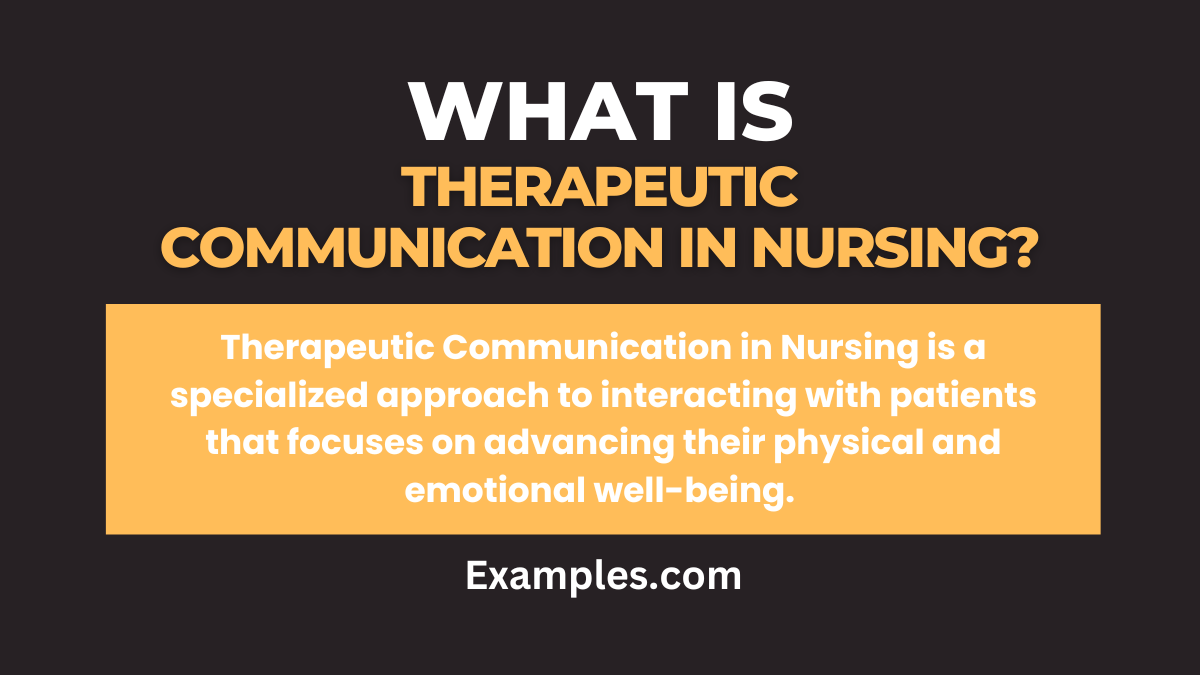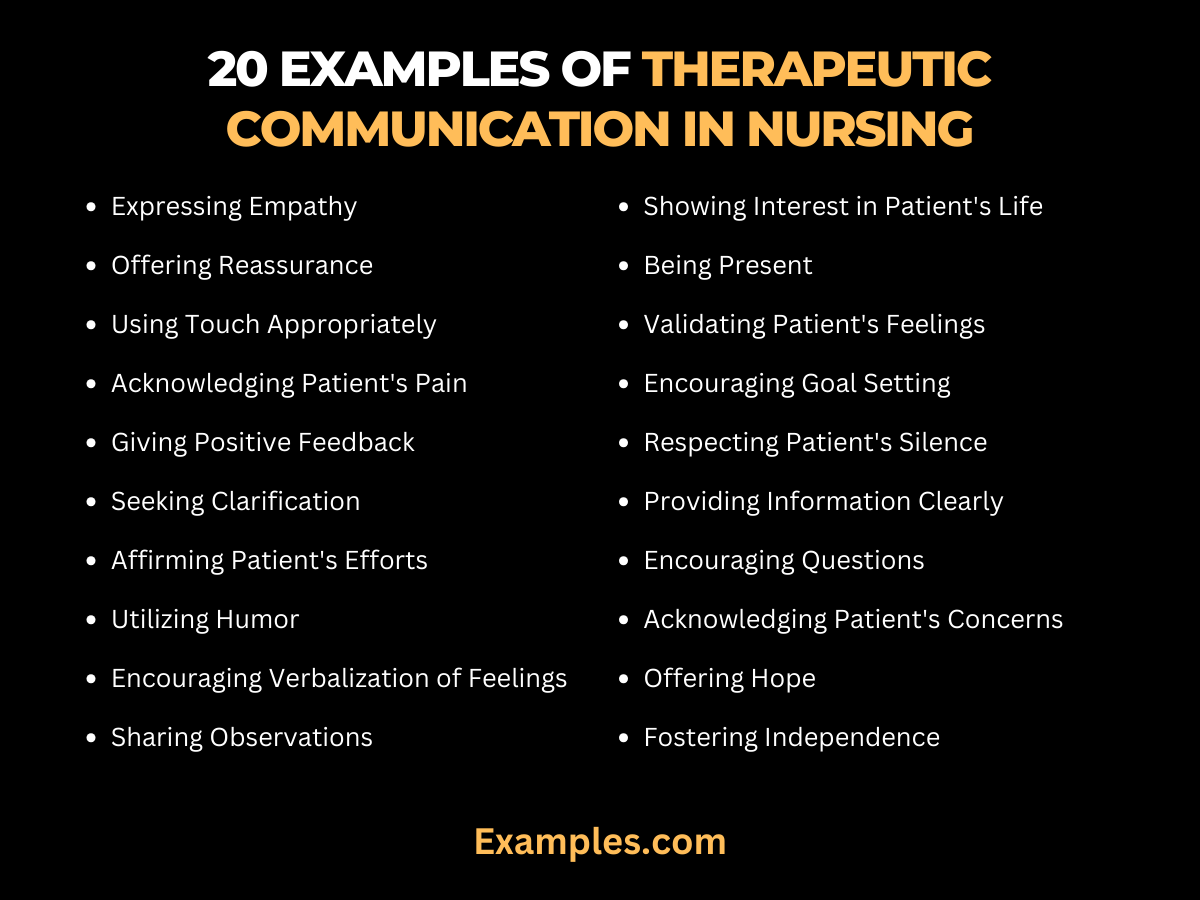19+ Therapeutic Communication in Nursing Examples
In the dynamic world of nursing, therapeutic communication stands as a cornerstone of effective patient care. This comprehensive guide delves into the nuances of such interactions, offering practical oral communication examples tailored for nursing professionals. Explore how to harness these skills to foster trust, empathy, and understanding with patients. Enhance your nursing practice with insights that go beyond basic care, ensuring your communication is as therapeutic as the care you provide.
What is Therapeutic Communication in Nursing?

Therapeutic Communication in Nursing is a specialized approach to interacting with patients that focuses on advancing their physical and emotional well-being. It involves using specific techniques and skills to connect with patients in a way that supports their healing process. This type of communication is more than just talking; it’s about understanding and responding to the patient’s needs, feelings, and concerns. It plays a crucial role in creating a supportive and trustful environment, essential for effective nursing care.
20 Examples of Therapeutic Communication in Nursing
Therapeutic communication in nursing is an invaluable skill, pivotal in enhancing patient care and facilitating effective interactions. This detailed guide offers 20 unique and distinct examples of therapeutic communication techniques, each with an extended explanation on how to implement them in a nursing context. These examples illustrate a variety of ways nurses can engage in meaningful communication, addressing both the emotional and physical needs of patients. By incorporating these communication methods, nurses can significantly improve patient experiences and outcomes, fostering a more compassionate and effective healthcare environment.

- Expressing Empathy: “I understand this must be tough for you,” showing that you recognize and empathize with their feelings. This approach helps patients feel understood and supported in their emotional experiences.
- Offering Reassurance: “You are in good hands,” providing comfort and reducing anxiety, especially in patients who are nervous about procedures or diagnoses.
- Using Touch Appropriately: A gentle touch on the shoulder can convey care and empathy, reinforcing verbal communication and providing a sense of reassurance.
- Acknowledging Patient’s Pain: “I see that you’re in pain, let’s see what we can do to help,” shows that you are attentive to their discomfort and committed to providing relief.
- Giving Positive Feedback: “You’re doing a great job with your exercises,” encourages and motivates patients, fostering a positive mindset towards recovery and rehabilitation.
- Seeking Clarification: “Can you tell me more about how you’re feeling?” ensures that you fully understand the patient’s condition and concerns, avoiding assumptions.
- Affirming Patient’s Efforts: “I can see you’re really trying to manage your health,” acknowledges their efforts and hard work, reinforcing their motivation to engage in their healthcare.
- Utilizing Humor: Appropriately timed humor can lighten the mood and relieve stress, helping to build rapport and make the patient feel more at ease.
- Encouraging Verbalization of Feelings: “How does that make you feel?” invites patients to share their emotions, promoting emotional healing alongside physical care.
- Sharing Observations: “I noticed you seemed a bit uneasy today,” opens the door to discussions about their emotional or mental state, showing attentiveness to their overall well-being.
- Showing Interest in Patient’s Life: “Tell me about your family,” to engage in conversation beyond their illness, showing that you care about them as an individual.
- Being Present: Providing undivided attention during interactions signifies respect and valuing the patient, enhancing the therapeutic relationship.
- Validating Patient’s Feelings: “It’s completely normal to feel scared before a surgery,” normalizes their emotions, reducing feelings of isolation or fear.
- Encouraging Goal Setting: “What are some goals you’d like to achieve during your recovery?” helps patients focus on positive outcomes and fosters a sense of purpose in their treatment journey.
- Respecting Patient’s Silence: Allowing moments of silence shows respect for their processing and decision-making times, acknowledging that not all communication is verbal.
- Providing Information Clearly: “Let me explain what this procedure involves,” helps in educating the patient and making them feel more in control of their healthcare decisions.
- Encouraging Questions: “Do you have any questions or concerns about your treatment?” creates an open dialogue, making the patient feel involved and informed.
- Acknowledging Patient’s Concerns: “I understand why that worries you,” validates their fears and concerns, building trust and rapport.
- Offering Hope: “Many patients have had great success with this treatment,” can provide a positive outlook and inspire confidence in the treatment process.
- Fostering Independence: “What would you like to do next in your care?” empowers patients to take an active role in their healthcare, promoting autonomy and involvement in their care plan.
Techniques and Strategies of Therapeutic Communication for Nurses
Therapeutic communication in nursing involves specialized techniques and strategies designed to enhance patient care. This guide explores various methods nurses can use to improve their interactions with patients, ensuring a more empathetic and effective exchange. From mastering the art of active listening to understanding non-verbal cues, these techniques and strategies are crucial for building trust and providing patient-centered care. Learn to implement these approaches to elevate your nursing practice and positively impact patient outcomes.
- Using Empathy Statements: Express empathy with phrases like, “I can see this is hard for you,” to show understanding and compassion.
- Offering Supportive Comments: Provide support with comments like, “We’re here to help you through this,” to reassure patients.
- Using Therapeutic Silence: Employ silence effectively, allowing patients time to process information and express themselves.
- Adapting to Patient’s Language Level: Communicate in a way that matches the patient’s level of understanding, avoiding medical jargon.
- Providing Educational Information: Educate patients about their condition in an easy-to-understand manner.
- Showing Unconditional Positive Regard: Treat every patient with respect and non-judgement, regardless of their situation.
- Utilizing Therapeutic Touch: When appropriate, use touch to convey care and empathy.
- Encouraging Expression of Feelings: Invite patients to share their feelings with prompts like, “Tell me more about how you’re feeling.”
- Validating Patient Concerns: Acknowledge and validate concerns with statements like, “Your worries are understandable.”
- Practicing Cultural Sensitivity: Be aware of and respect cultural differences in communication styles and preferences.
Role of Therapeutic Communication in Modern Nursing Practices
Therapeutic communication is integral to modern nursing practices, playing a key role in patient care and recovery. It encompasses various communication techniques that nurses use to connect with patients, providing emotional support and understanding. This aspect of nursing practice is crucial for building strong patient-nurse relationships, ensuring patient comfort, and fostering an environment conducive to healing. In this guide, explore the multifaceted role of therapeutic communication and how it shapes contemporary nursing practices, ultimately leading to improved patient experiences and outcomes.
- Enhancing Patient Trust: Build trust by consistently providing clear and honest information.
- Facilitating Patient Autonomy: Encourage patients to take an active role in their care decisions.
- Managing Patient Anxiety: Reduce anxiety through reassuring and calm communication.
- Improving Patient Education: Use clear and simple explanations to educate patients about their health.
- Supporting Emotional Well-being: Address emotional needs by being attentive and compassionate.
- Promoting Patient Safety: Use communication to ensure patients understand safety procedures and precautions.
- Encouraging Patient Participation: Motivate patients to participate in their care by discussing their goals and preferences.
- Facilitating Interdisciplinary Communication: Act as a liaison between patients and other healthcare team members.
- Deescalating Conflict: Use calm and respectful communication to resolve conflicts or misunderstandings.
- Supporting Family Involvement: Include and communicate effectively with family members, respecting their role in patient care.
What are the Most Effective Techniques in Therapeutic Communication for Nurses?
Therapeutic communication is a key component in the field of nursing, vital for establishing a strong rapport with patients and ensuring the delivery of high-quality care. This guide highlights the most effective techniques in therapeutic communication specifically tailored for nurses. These methods are not only crucial for building trust and understanding with patients but also play a significant role in improving patient outcomes. By mastering these techniques, nurses can create a more empathetic, supportive, and effective healthcare environment.
- Active Listening: This involves fully focusing on the patient, not just hearing their words but also understanding the underlying emotions and messages. Active listening shows the patient that their concerns are being taken seriously, fostering a sense of respect and care.
- Empathy: Expressing empathy is about genuinely understanding and sharing the feelings of the patient. It creates a bond of trust and reassurance, making patients feel valued and understood.
- Clear and Simple Communication: Using straightforward, jargon-free language is essential. This ensures that the patient understands their condition and care plan, fostering better cooperation and reducing anxiety.
- Open-Ended Questions: These encourage patients to express more than just ‘yes’ or ‘no’ answers, providing deeper insights into their feelings, thoughts, and needs.
- Reflective Responses: Reflecting or paraphrasing what a patient has said can confirm that the nurse has understood their message correctly, helping to clarify communication and prevent misunderstandings.
- Non-Verbal Communication: This includes maintaining eye contact, using appropriate facial expressions, and attentive body language. Non-verbal cues can convey empathy and understanding, often speaking louder than words.
- Reassurance and Encouragement: Offering reassurance helps alleviate fears and anxieties. Encouragement motivates patients, especially those struggling with long-term conditions.
- Respecting Personal Space: While therapeutic touch can be comforting, respecting a patient’s personal space is crucial, as it can significantly impact their comfort level.
- Cultural Sensitivity: Understanding and respecting cultural differences in communication is essential, as it can influence how patients perceive their care and interact with healthcare providers.
- Patient-Centered Approach: This approach involves seeing the situation from the patient’s perspective, ensuring their needs, preferences, and values are at the forefront of all communication.
How Can Nurses Improve Therapeutic Communication?
Improving therapeutic communication is crucial for nurses to provide the best possible care for their patients. This comprehensive guide focuses on strategies nurses can implement to enhance their communication skills. Effective communication not only improves patient outcomes but also strengthens the nurse-patient relationship, making it a vital aspect of nursing care.
Firstly, nurses can benefit from continuous education and training in communication. Workshops and courses on therapeutic communication can provide nurses with the latest techniques and approaches. Additionally, practicing active listening is key. This means not only hearing what the patient says but also understanding the underlying emotions and concerns.
Another strategy is to be aware of non-verbal cues. Body language, eye contact, and facial expressions can convey empathy and understanding, often speaking louder than words. Nurses should also aim to create a safe and open environment where patients feel comfortable sharing their thoughts and concerns.
Furthermore, adapting communication styles to meet the unique needs of each patient is important. This involves recognizing and respecting cultural differences, language barriers, and varying levels of health literacy.
Regular self-reflection and seeking feedback from colleagues and mentors can also help nurses identify areas for improvement in their communication skills.
In summary, by focusing on education, active listening, non-verbal cues, adaptability, and self-reflection, nurses can significantly enhance their therapeutic communication skills, leading to better patient care and outcomes.
How Does Therapeutic Communication in Nursing Practice Improve Patient Safety?
Therapeutic communication in nursing practice is not just about building rapport with patients; it plays a crucial role in ensuring patient safety. This guide explores how effective communication can prevent errors, misunderstandings, and misinterpretations in a healthcare setting.
Effective therapeutic communication helps in accurately assessing patient needs and concerns. When nurses communicate effectively, they are better equipped to understand and interpret patient symptoms and feedback, which is essential for accurate diagnosis and treatment.
Moreover, clear and precise communication is vital in educating patients about their conditions and the treatments they will receive. This includes explaining medication regimens, post-operative care instructions, and potential side effects. When patients have a clear understanding of their care plan, the likelihood of medication errors or non-compliance with treatment is significantly reduced.
Effective communication also fosters a culture of safety in healthcare settings. It encourages openness, where patients feel comfortable discussing their concerns or asking questions. This openness can lead to early identification of potential issues before they escalate into serious problems.
Additionally, therapeutic communication can help in managing patient expectations and reducing anxiety, which is particularly important in high-stress environments such as emergency rooms or intensive care units. When patients are calm and informed, they are less likely to make decisions that could jeopardize their safety.
In summary, therapeutic communication in nursing is essential for patient safety. It facilitates accurate assessment, effective patient education, a culture of safety, and reduced patient anxiety, all contributing to safer healthcare environments.



